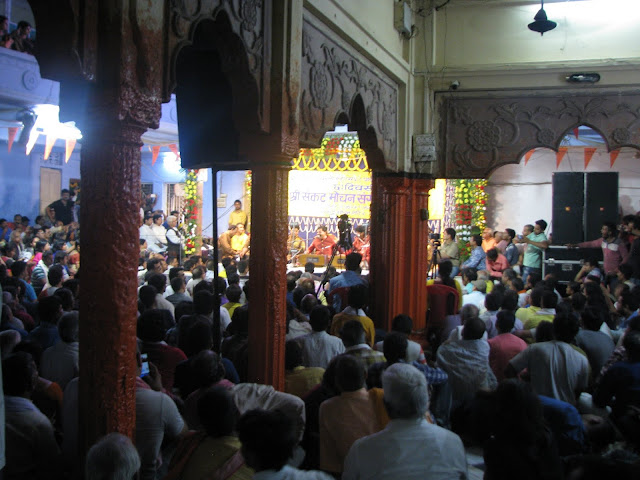Beyond the black box: Sankat Mochan 2019
Musical
offerings in Hanuman’s court
Thanks
are due to the team at Sruti. An edited version of this piece appears in their
September 2019 issue.
Ustad Moinuddin Khan, prior to his performance, shared, “This is where I derive pleasure in playing”
while Vidushi Kaushiki Chatterjee
conveyed respects of each of her family members to the deity. Her father too,
like was the case with few other artists, had previously performed at the
venue. Kankana Banerjee, the first lady to perform at Sankat Mochan, set up a
record of sorts by performing at the venue
for the 41st consecutive year. Shailaja Khanna in her article, An
ode to the master musician, put it thus, “the
concert is regarded as on offering – a ‘hazari’ which literally translates to
formal presence in the court of the ruler or divine”. Banaras too has a
role. Kathak maestro Shovana Narayanan had stated, during a performance at a
temple nearby, “at temples of Banaras we
perform for God and ourselves, neither for money nor for fame”. As a corollary,
she added, “the performances in town have
a unique depth and intensity”. Sankat Mochan Sangeet Samaroh stands out not just on account of it’s being held
in a temple, free entry or the ‘baithak’
arrangement but also by virtue of the bonding it boasts with artists.
The line-up of artists has few parallels. On day 2 of the
2019 edition, for example, Pandit Hariprasad Chaurasia and Ustad Rashid Khan
performed one after the other. Pandit Hariprasad Chaurasia- one of the biggest
names in Indian classical music today and Ustad Rashid Khan – an artist at the
peak of his craft. And these were just 2 of the 7 performances of the evening
in an event spanning 6 evenings. Like during the previous year’s performance, I
noticed the age driven shake of Pandit Hariprasad Chaurasia’s hands and much like that
performance once the flute reached his lips magic flowed. Ustad Rashid Khan,
sipped tea from kullad as he sang, and
his performance made me recall Pandit Bhimsen Joshi’s very apt praise for him,
“assurance for the future of Indian vocal
music”. Pandit Vijay Ghate accompanied Ustad Rashid Khan. A flamboyant charmer,
Pandit Vijay Ghate had, during the previous year’s edition, accompanied Pandit Hariprasad
Chaurasia. This year, together with Ustad Rashid Khan, he re-defined
collaboration.
This uniqueness goes beyond the artists. This festival, one
of the biggest annual music celebrations in the country, is where the worlds of
music and devotion meet. During the performances it was not uncommon to come
across people reading Hanuman Chalisa;
the temple has stacks of these. Thousands of devotees thronged the temple on
Saturday, like they did during rest of the year, and the festival, remained
unaffected. Talking of ambience this is a place which allows you to sleep,
stroll languorously, sit taking support of pillars; in other words – be
comfortable as you savour music or bhakti.
Chaos, here, like elsewhere in Banaras, is bereft of the negative connotation
one usually associates it with. It rather generates a positive energy. Most
people seem to get what they come seeking for - music, lord Hanuman, or else.
The festival walked the talk when it came to environment,
withoutthe proverbial shouting from the roof-top. The basics were in place. Kullads were placed along-side the water
dispenser at one end. At the other end an old uncle served water – to be
scooped with bare hands. Once in a while a younger person came, filled water
from the well adjacent, and toppled it in the container the uncle used. The
simplicity in arrangements, including the bare minimum decoration on stage, ensured
that not only was the ecological foot-print at the lower-end but also that the
local people were not cut-off, a lesson many in the not-for-profit world could
learn from. Next to the water point stood the stalls selling flowers, sweets
and paan. Not surprisingly it was the
stall selling sweets that people thronged the most; here too plastic was absent.
We went with empty steel box and glass on each of the days and one day also
with food.
Less people appeared to have attended this year’s edition compared
to the previous year. Then it had been difficult to spot the white cover of the
mattresses in the space in front of the stage or the red of the carpet, in the
open area, where a large screen is put up. The local people who formed majority
of the audience were well-versed with nuances of Indian classical music and
this year one of the vernacular newspapers too devoted ample space. It had
musicians of high repute write on the performances through-out the week. One of
them observed “youth had attended in
large numbers preferring classical music to Whatsapp during the period”. The
event, of course, was screened live on Facebook.
Back to the artists and some of them expressed keenness to
perform during the coming year’s edition as well. Dates have been announced;
the evening of 12th April, 2020 will see the first set of
performances of the 97th edition of the Sankat Mochan Sangeet Samaroh.
The image are from 2018 and the schedule from the 2019 edition.
Sankat Mochan
2018 and Dhrupad Mela
2019 from First Post.




Comments
Post a Comment